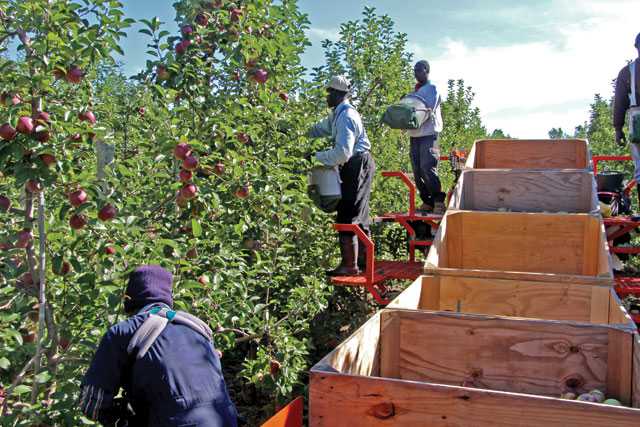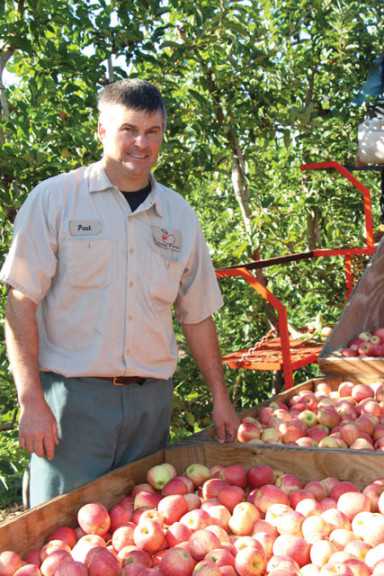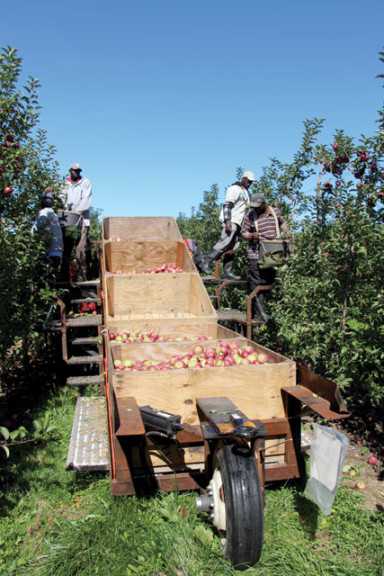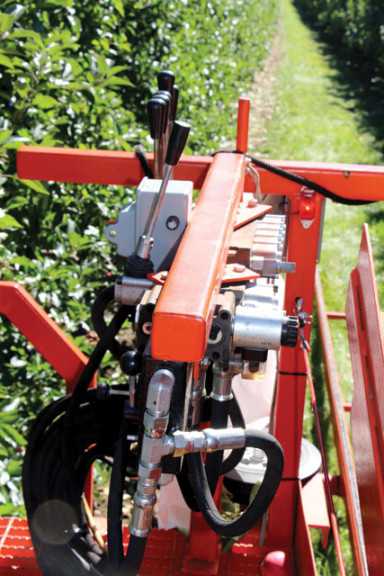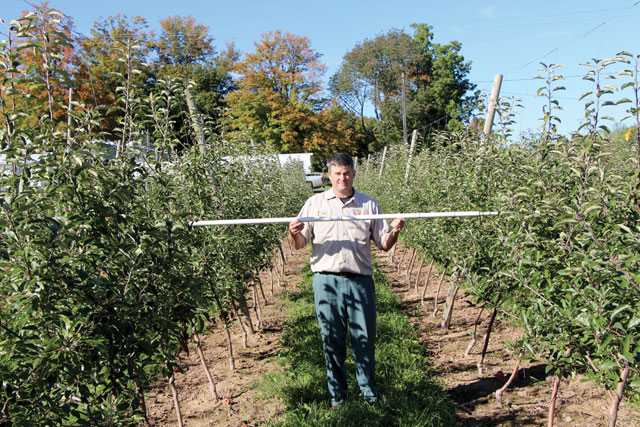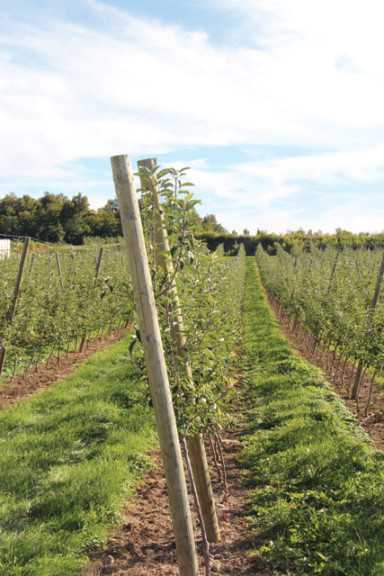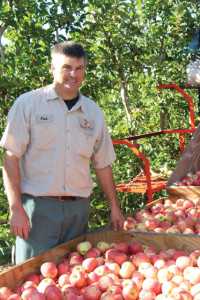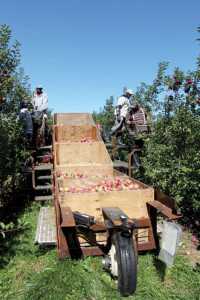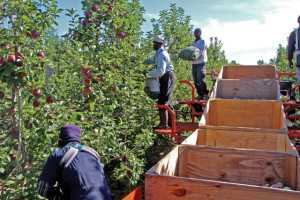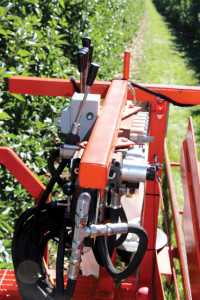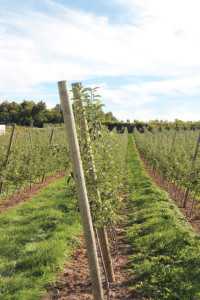Mechanization Finds Its Place In The Modern Orchard
[blackoutgallery id=”55816″]
Paul Wafler is a self-proclaimed tinkerer. Over the years, he has been responsible for modifying and customizing all of the farm equipment used on his family’s 1,100-acre orchard and nursery in Wolcott, NY. No equipment used on Wafler Farms is without modifications.
It was only natural that mechanization would find its way into the Wafler orchard. An innovative and progressive fruit grower, Wafler has developed a mechanical harvest platform and a unique growing system to accompany the harvester to take his family into the next decade of tree fruit growing.
The Wafler Harvester

Pickers with bags are responsible for picking zones, designed to span the whole tree, so the fruit comes to the pickers. (Brian Sparks photo)
Wafler’s harvesting platform is a marriage of efficiency, cost savings, and ease of use, according to Wafler. Depending on the crop load, six to eight pickers are positioned at different levels of stair-step catwalks, equipped with a protective railing for safety. Pickers with bags are responsible for picking zones, designed to span the whole tree, so the fruit comes to the pickers. The first pickers walking on the ground pick from their shoulders down. The next set of pickers, stationed on the harvester, pick from the second catwalk up to their shoulders. The last set of pickers, on the highest catwalk, pick from the rail to the top of the tree.
“Everybody has the same workload,” says Wafler of the benefits of picking in zones. “It’s shocking how much time you save by letting the fruit come to you and not going to the fruit. Because the man is right next to his bin, he doesn’t have to do any extra movements.”
Wafler’s picking crew prefers using the harvester to ladders. They may have been skeptical at first, but now when Wafler asks them, they don’t hesitate to cite the ease of using the platform.
The bins are positioned at a slope and on two connected carriers, in what Wafler likens to a tractor-trailer car carrier. The harvester constantly carries 10 bins in two groups of five. Five are used for picking, and five are carried on a docking trailer, which resembles the car carrier in a raised position. The bins in use are positioned on a slope next to each picker.
“It’s much easier to have (the bins) on an angle. All the apples go to the front of the bin, they don’t roll around. With multiple levels to stand on, it’s very easy on the picker’s backs to get down into the bin to empty them without bruising the apples,” said Jeremy Bryant, a manager at Wafler Farms.
The harvesters will cover two to six rows at the same time, and when the bins are filled, the five full bins are transitioned to the ground. While this transition is occurring, the bins can be topped off by pickers as they are coming off the harvester.
“As soon as the full bins are out, the bed raises up, and it power feeds the five (new bins) on, which literally takes seconds,” says Wafler.
As the new bins come on the harvester, the pickers begin the process again. This design allows for continual harvesting.
Wafler has used his harvester as a pruning platform and instead of a ladder when training trees. The harvester can carry up to 5,000 pounds so it is possible to carry all the supplies needed for a day’s work, whether pruning, harvesting, or working on trellising. He sees the harvester as an invaluable piece of equipment for orchard maintenance.
The Math Behind The Machine
Wafler calculates all work on the harvester in travel time in feet per minute. He’s able to calculate how fast the harvester should be traveling and how much the day’s work will cost per acre.
“If we want to go out there and we want to budget X number of dollars for any task, it’s very easy to figure out what our true costs are going to be. Because within minutes we’re driving the machine, doing the tasks, we determine if we need to drive it faster or if we need to drive it slower. So we can quickly note our linear feet that we’re traveling, and we can calculate our cost per acre.”
This calculation helps Wafler recoup expenses on the harvester, and also put more money back into the picker’s hands at harvest.
“Our harvest cost this year will be back where we were doing our piece rate back in the late ’80s, but my men are guaranteed to take home at least 25% more than they would if they were on the ground,” says Wafler. “These machines owe me nothing after a year and a half of running. They’re all paid for because of the labor savings. Picking production is increased by 45% to 65% on first pick and 65% to 85% on second pick.”
Wafler notes that, thanks to his harvester, he has been able to average 3% to 5% more harvested fruit falling in the extra fancy category. That, in itself, helps increase profits in the orchard. “We were capturing another $12 to $14 a bin (with the increase of extra fancy apples) and we were saving at least $3 to $4 a bin on labor. It’s easily $15 to $20 in savings per bin. We put about 3,000 bins through the machine a year,” says Wafler. “You get pretty fast payback on a machine. That’s just harvest. We’re not talking pruning, or some of the other tasks.”
Depending on the grower’s needs, Wafler has a narrow or a wide machine. He does note, though, that the Wafler Harvester does not work well in super spindle orchards. The plantings are too condensed for multi-operator mechanization to really be successful. The harvest platform must travel at very fast speeds to have enough surface area to work with a group of people.
Taking Tall Spindle To Another Level
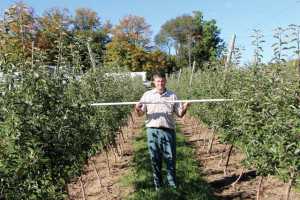
Paul Wafler highlights his tall spindle tip training system, where the trees are tipped out in narrow rows and tipped in in wide rows. (Photo credit: Brian Sparks)
What started out as introducing mechanization into the orchard has turned into much more for Wafler.
He tested the harvesting machine in his family’s older orchards for picking, and what he discovered was completely accidental.
“We noticed right away with some of our older orchards that the training system had gone in disarray, and we were excited when we went on the east side of a tree because the trees all leaned to the east because of prevailing winds,” says Wafler. “One of the two main problems with orchard mechanization is how to position catwalks so that the worker can reach the entire tree and yet not damage the un-picked fruit. (With the trees leaning to the east), we could do everything to the tree without the catwalks touching any part of the tree; it was almost effortless.”
Wafler decided to break some trellising poles and tilt the rows of the older orchard to a degree, similar to what Mother Nature had done. He refers to this training system as the tall spindle tip, or TST.
This system offers pickers an ease of picking when used with the harvester. With the trees leaning toward the pickers, they can pick through the tree, and pick everything from one side. This means pickers can cover two complete rows with one pass.
“What I’m trying to ultimately do is change our whole orchard design. Not to fit this machine, but to fit any type of mechanization that is going to go forward,” says Wafler. “(If) we want to put in an orchard, we have to first change the style of orchard a little bit to adapt to more efficiencies. My system isn’t just the picking; it starts the day that they plant the trees.”
The training system consists of a typical tall spindle tree, angled slightly to bring the top of the tree closer to the picker. The row widths vary, though, between a narrow and a wide row. Since pickers are picking through the tree, there isn’t a need for the same row spacing to allow for a harvester to travel through. The wider row is 13 feet wide, with the trees tipped in. The narrow row, with the trees tipped away, is 7 feet wide.
Wafler plants his trees approximately 3 to 3.2 feet apart, variety dependent, and he is averaging around 1,400 trees per acre. He has also removed the odd or “guest” row from his plantings. As mechanization was introduced to the Wafler orchard, he realized the inefficiencies of that additional row.
“The remaining problem (with mechanization) is to ensure that you have no guest rows. This harvest system doesn’t work well with Gala on one side of the row and Fuji on the other,” says Wafler. “We decided that we needed to change to a single pass where we’re picking two rows all the time,” says Wafler. “We never have to think about ‘how do we deal with that odd row?’ and that’s created a lot of labor savings, a lot of management savings.”
With this training system, Wafler sees an advantage for the narrow rows offering better light interception as well as saving time. “This is very specific for high yield, high quality, and high efficiencies,” says Wafler.
Wafler estimates that he has approximately 200 acres planted with the TST training system and will continue to plant this way for at least the next 10 years. He hopes to introduce hail netting on the narrow rows.
“The wide row that the machine, the sprayer, or the tractor is in, we don’t have to worry about covering that because the tree will be 85% protected under (the hail netting on the narrow rows) because of the angle of the tree,” says Wafler.
The Future Of The Harvester
Wafler is confident that there is a place in the orchard for a mechanical harvester. He is ready to expand production with the creation of Huron Fruit Systems, a company formed to produce the harvest platform and related equipment.
“I’m that satisfied with the improved efficiencies and the overall machine design. Now we need to push it to other areas (of the country) and other growers can get the advantage we are getting with this versatile machine,” says Wafler.
Paul Wafler’s brother, Walter, is teaming up to run Huron Fruit Systems. “We’re expecting to go into production in the first part of 2014. We’ll be taking orders for units for the 2014 harvest season,” says
Walter Wafler. “We expect to have production in time for the 2014 harvest season.”
The consummate tinkerer, Paul Wafler is also working on a bin washing and sanitizing system for use in his family’s packinghouse. He estimates that with this process, the bins would be out in the environment for a maximum of two hours during harvest, and an hour before being back in the packing house.
Paul Wafler is also eyeing the future of food safety in the orchard. He says he is ready to make modifications to the harvester if needed.
“If they say a bin can never touch the ground again, we’re on it, we’re ready for it. We’re ready for whatever comes down the road with food safety sanitation. We’re already looking that far ahead because we’re able to achieve so much more with this harvester,” he says. “I’m always thinking ‘there could be a better way,’ ‘there should be a better way,’ ‘we should try a better way.’”
For more information on the Huron Fruit Systems harvest platform system, visit www.HuronFruitSystems.com.
Controlling Growth Through Ripping And Tearing
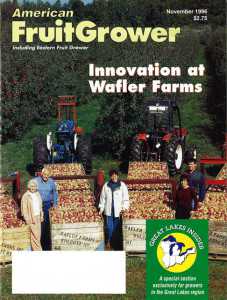 Paul Wafler’s family was featured in the November 1996 issue of American Fruit Grower. In that story about the innovations his family has implemented on their orchard, it was mentioned that his family rips branches instead of cutting to prune. At the time of printing, this was a typical practice in Germany and Holland.
Paul Wafler’s family was featured in the November 1996 issue of American Fruit Grower. In that story about the innovations his family has implemented on their orchard, it was mentioned that his family rips branches instead of cutting to prune. At the time of printing, this was a typical practice in Germany and Holland.
Paul’s father, Fritz, noted that there seemed to be less fire blight with ripping branches because individual cells are not cut and the branch heals faster and fewer suckers are produced.
Tearing branches is a practice still used in the Wafler orchard. “There’s so many varieties that we feel there are certain times of year that we pull branches off. It can make a very large wound; it can look pretty rough, pretty aggressive to the tree, but the tree responds differently to that torn off branch than it does with a cut branch,” says Paul Wafler. “You’ll get less re-growth in that area, and you can control some of the vigor, there’s just a lot of positives with ripping branches.”
He noted that with the family’s Gala plantings, ripping is the standard for pruning. “We’re constantly tearing branches out or we’re cutting. If we’re cutting, we’re trying to get aggressive renewal,” he says. “If we want to slow down the vigor and not get a lot of renewal there, we’ll tear the branches out. It might be a sucker or it might be a branch that is ¾ inch in diameter.”
Wafler has stopped using hydraulic or air pruning as well. “It’s all done with a hand-lopper. Not a hand-clipper, but a hand-lopper, because nothing is allowed to get bigger (than ¾ inch in diameter) in any of these fruiting structures. It’s not needed. It becomes very efficient and fast for the pruning too,” says Wafler.
He notes, though, that he will rip a branch out if the angle or the desired response merits it, saying “I love to go grab a big branch and rip it.”





